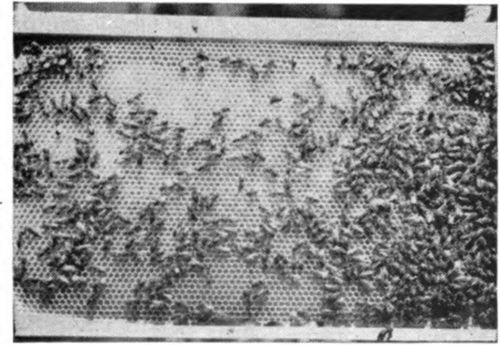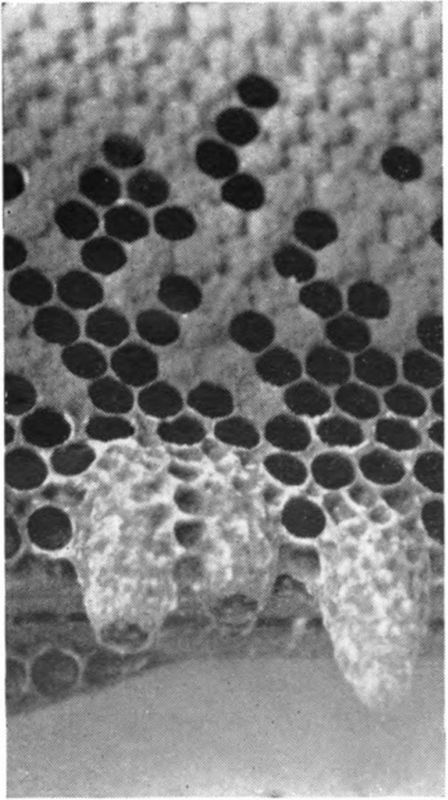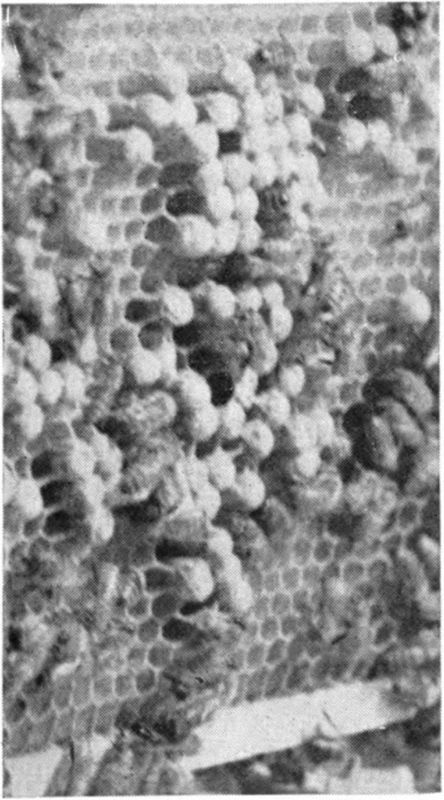Package Bees - From Arrival To Honeyflow. Part 3
Description
This section is from the book "Beekeeping for Beginners", by G. H. Cale, Jr.. Also available from Amazon: Beekeeping for Beginners.
Package Bees - From Arrival To Honeyflow. Part 3
In making the two-week examination remove the feeder, and, smoking gently, roll back the cloth to where the queen cage is suspended. Then spread the frames at this point and remove the queen cage, examining it to see if the queen has been released. Then lift out one of the center frames which has faced the suspended queen cage. If you see eggs or larvae you can be sure the queen is present and laying. Do not bother to look for the queen. Remove the empty package, place the remaining frames in the hive (on either side of the original five) and close the hive, replacing the feeder and the cover as quickly as possible-but with easy motions.
To help you in colony manipulation it is advised that the original five frames be numbered one through five consecutively. When the bees start to build comb on frames numbered one and five it is advisable to turn them around so that the sides which were not facing the bees previously now face toward the cluster of bees. Place a frame with foundation between the frames numbered one and two and between the frames numbered four and five. In this way the bees are partially forced to expand their comb-building efforts.

Worker bees in the process of drawing foundation. Usually worker bees will start their comb building efforts in the approximate center of the frame from end to end and closer to the top bar than to the bottom bar.
Three weeks from the day you hived the package you may again make an examination of the colony. Be sure to refill the feed pail during every examination. The bees need lots of food when they are in the process of wax secreting and building. When there is enough bloom so that they may secure nectar from flowers they will no longer need the sugar sirup and, in fact, will no longer take the sirup from the feeder pail.
Let the bees be the judge of whether or not they need sirup. Do not take the feed away from them simply because you have seen numerous flowers. There are many factors which influence nectar secretion and an abundant bloom does not necessarily mean an abundance of nectar.

Worker and queen cells, approximately natural size. The worker cells are horizontal in the comb while the queen cells (there are three of them in the illustration) are larger and are built vertically in the shape of smallsized peanuts. Sometimes they are found suspended at the bottom of the combs, sometimes they are developed by the bees in the middle of the comb. The queen emerges with her head facing downward. Queen cells are found in the hive only under certain conditions (discussed in the following pages) while worker cells are always present. There are approximately five worker cells to the linear inch.
During this three-week examination check again to make sure that the queen is laying well. By this time there should be considerable sealed brood in the combs. Do not attempt to change the position of any of the frames in the hive at this time. Three weeks after the package has been hived is the period of lowest ebb in colony strength. Some of the bees which were shipped in the package have died and none have yet emerged from the cells to take their place. Toward the end of the fourth week young worker bees will start to emerge from the cells, and during the fifth week they will emerge in great numbers. From the fifth week on the number of worker bees will increase fairly rapidly.

Drone brood-smaller than natural size. With a good queen very few drone cells will be present in your colony. Notice the characteristic bullet-shaped appearance of the sealed drone brood in this picture. They may easily be distinguished from worker cells by the way in which they protrude beyond the rest of the cells in the comb. The overproduction of drones is one thing that should always be discouraged. Usually the bees will build drone cells in any section of the comb that has been damaged. Because of this the beekeeper should be careful when working his colony not to damage the comb.
From previous information you now know the difference between the three types of bees in the colony-the worker, the queen, and the drone. Nothing has been said, however, about the difference in the cells from which these bees emerge. A careful examination of the accompanying pictures should reveal this information to you.
During the fifth week you should conduct another examination of the colony. Check again for the queen and make sure that the brood nest is expanding and that the bees are drawing their foundation well. It will help if you will move sheets of foundation that have not been drawn, up next to the brood nest. A word of caution here-always put frames with empty comb or foundation up to and not into the brood nest. If the frames of the brood nest are separated there is danger of some of the larvae being chilled if the weather is cold.
By the end of the sixth week the fruit bloom is over and clover or other bloom is close at hand. It would be well to talk with neighbor beekeepers and find out from their experience just when you may expect the main honeyflow to start. Usually by the end of the sixth week you may stop feeding sirup. There should be plenty of bloom present by that time to supply natural sources of food for the bees. When feeding is stopped it is neither necessary nor advisable to remove the feeder shell. If the shell is left on and the corner of the oilcloth left turned back it provides the bees with an empty space in which they may cluster. If the weather is warm, or the colony large in numbers, this space will do much to prevent swarming.
Continue to:


